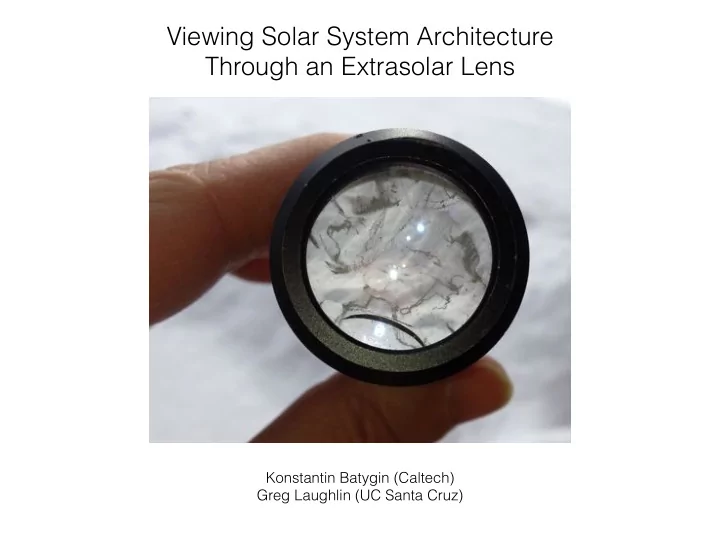

Viewing Solar System Architecture Through an Extrasolar Lens Konstantin Batygin (Caltech) Greg Laughlin (UC Santa Cruz)
Planets with known masses
Jupiters ! (10% of Sun-like stars) Hot Jupiters ! (1% of Sun-like stars)
Planets with known radii
Hot Jupiters (1% of Sun-like stars) Close-in sub-Jovian planets (50% of Sun-like stars)
Kepler Planet Candidates (sub-Jovian) 100 R � � R 0 1 ✓ a ◆ r = log 10 R � Jupiter Saturn Neptune Earth Mercury
3 planet 4+ planet systems systems 2 planet systems � R 0 1 Mars Earth single planet Venus systems Mercury Jupiter Saturn Neptune Earth Mercury
Minimum Mass Solar Nebula (Hayashi 1981) a ⌘ − 1 . 5 ⇣ g / cm 2 Σ = 1700 1AU f dust ∼ 0 . 5% a < 2.7AU f dust ∼ 1 . 5% a > 2.7AU
Minimum Mass Solar Nebula (Hayashi 1981) gas a ⌘ − 1 . 5 ⇣ g / cm 2 Σ = 1700 1AU solid f dust ∼ 0 . 5% a < 2.7AU f dust ∼ 1 . 5% a > 2.7AU Minimum Mass Extrasolar Nebula (Chiang & Laughlin 2013) a ⌘ − 1 . 6 Σ ∼ 10 4 ⇣ g / cm 2 1AU f dust ∼ 0 . 5%
Relative to other Sun-like, planet-bearing stars, the Solar system’s terrestrial region is severely depleted in mass.
Relative to other Sun-like, planet-bearing stars, the Solar systems’ terrestrial region is severely depleted in mass. Our proposition: Long-range (a few AU) migration of Jupiter in the Solar nebula Orbital excitation of planetesimals by resonant sweeping Destructive collisional cascade and removal by aerodynamic drift Resonant shepherding of close-in planets by drifting debris
3:2 resonant lock established
Jupiter’s inward trek resonantly sweeps up planetesimals Jupiter planetesimals + gas 2:1 MMR
Jupiter’s inward trek resonantly sweeps up planetesimals Jupiter planetesimals + gas Adiabatic invariance dictates excitation of orbital eccentricity h i √ a p 1 − e 2 1 − = const . 2:1 MMR
B planetesimal - Jupiter period ratio 2:1 MMR 3:2 resonant capture and transport 1:1 outward scattering time (years)
Jupiter’s orbital migration A 2:1 resonance g n i r e t t a c orbital eccentricity s d r a w t u o resonant transport 100 km planetesimals unswept disk semi-major axis (AU)
Jupiter’s orbital migration A 2:1 resonance orbital eccentricity outward scattering unswept 10 km planetesimals disk resonant transport semi-major axis (AU)
Jupiter’s orbital migration A 2:1 resonance orbital eccentricity g n i r e t t a c r s e d s r o a w n 1000 km planetesimals t a u unswept n o t t disk r a n s p o r t semi-major axis (AU)
Jupiter 2:1 MMR
Jupiter planetesimals 2:1 MMR
Jupiter planetesimals 2:1 MMR M tot /m 2 π h e i tan h i i a 3 π s 2 v K h e i ~ a collision every ~20 orbits ν ⇠ n σ v =
Collisions can lead to accretion fragmentation or
Collisions are catastrophic if: ✓ R ◆ 1 . 36 ◆ ✓ v 2 ✓ m 0 ◆ > 1 enc 2 ρ M 2 1 cm (Leinhardt & Stewart 2009)
Collisions are catastrophic if: 10,100,1000 km ∼ e v kep ✓ R ◆ 1 . 36 ◆ ✓ v 2 ✓ m 0 ◆ > 1 enc 2 ρ M 2 1 cm 3 g/cm 3 (rock) impactor-target mass ratio of ~10% yields fragmentation! (Leinhardt & Stewart 2009)
Jupiter’s migration shepherds planetesimals inwards and grinds them down to smaller sizes
Aerodynamics ~0.005 s 1 − 3 c 2 s v gas = v K ϕ = v K (1 − η ) ˆ ˆ Gas is sub-Keplerian ϕ v 2 K a drag = − π C D small (<1km) planetesimals 2 m s 2 ρ gas v rel v rel . feel a head-wind
g orbital radius (AU) f e d c b orbital decay of a putative Kepler-11 system under the influence of a drifting population of 100m planetesimals time (years)
Summary Jupiter’s current orbit is a consequence of inward-outward migration, facilitated by a resonance with Saturn Jupiter’s orbital migration The inward phase of Jupiter’s migration entrained planetesimals 2:1 resonance resonant transport a r w u t unswept o into interior resonances and led to orbital excitation The resulting collisional avalanche generated a debris disk that would have aerodynamically driven any pre-existing short planets into the Sun
Links with observations A strong anti-correlation between the existence of multiple close-in planets and giant planets at orbital periods exceeding ~100 days within the same system. The spectral energy distributions of protoplanetary disks hosting gap-opening planets should exhibit infra-red enhancements. The morphology of the collisional heating should be strongly a-symmetrical.
Recommend
More recommend